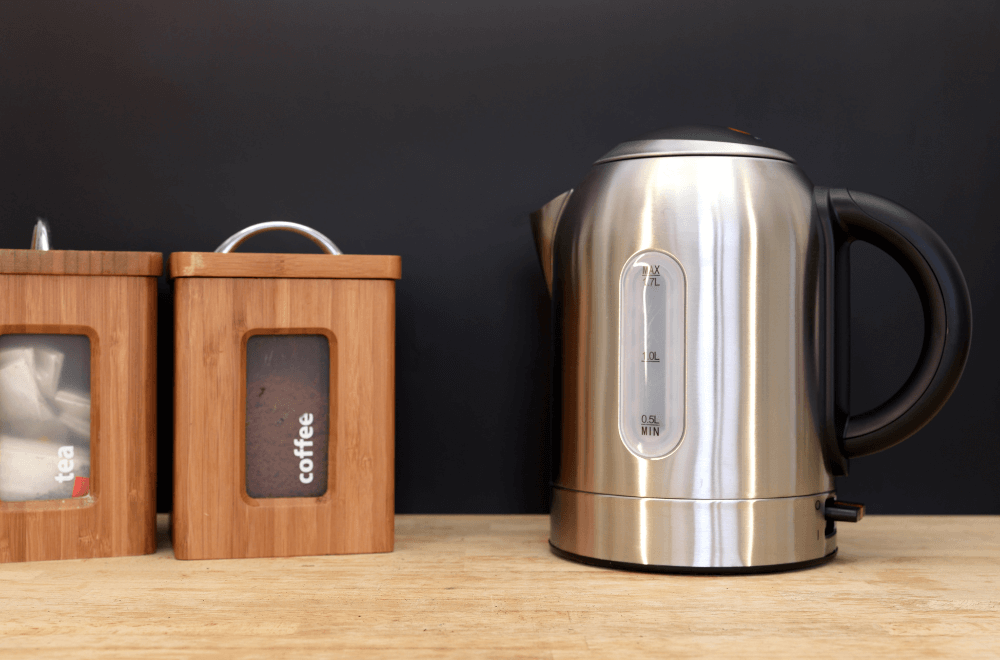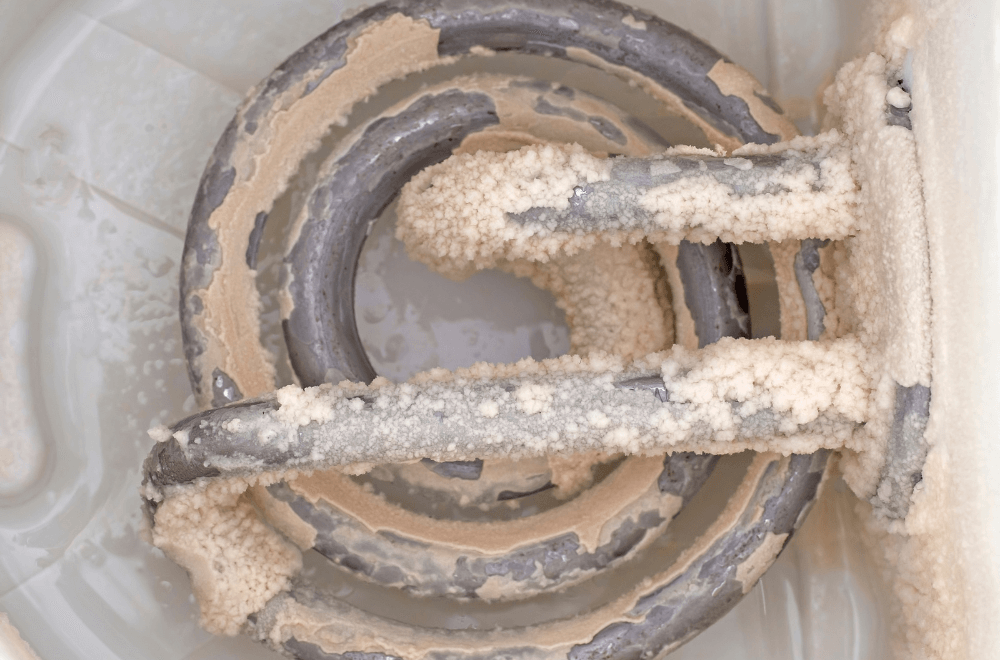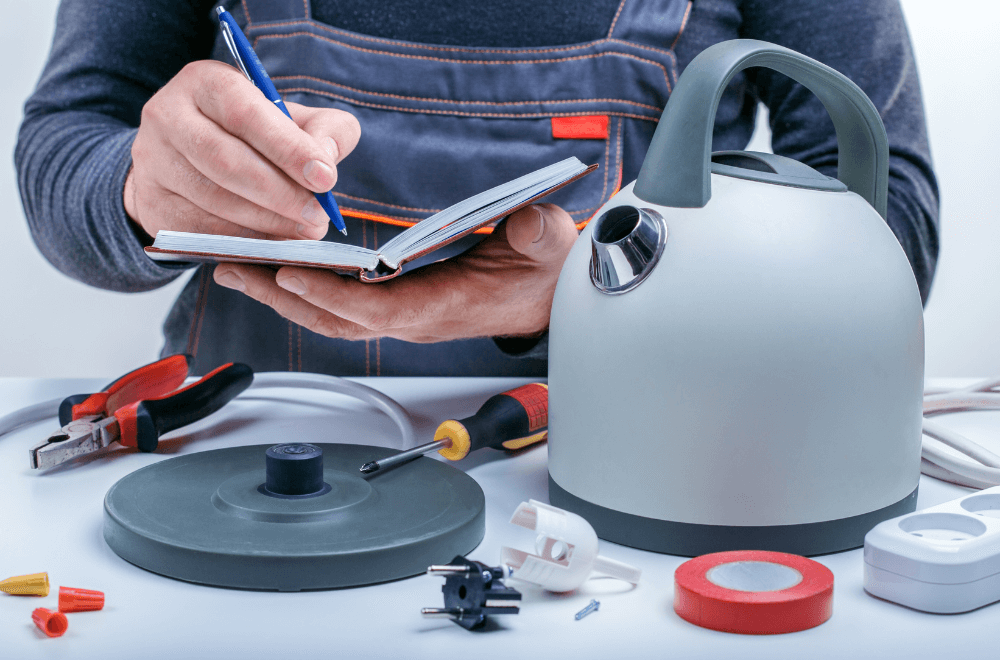Are you wondering, “do electric kettles turn off automatically?” Check out this article to see how electric kettles work and what to do when they go wrong.

One of the best features of an electric kettle compared to a stovetop kettle is its automatic shut-off function. It saves you a lot of time from standing by the stove, gluing your eyes to the kettle to keep it from spilling.
An electric kettle has a bimetallic strip underneath that senses the temperature during the boiling process. When you turn on the switch, the strip begins to bend to a certain level. When water begins to boil, the bent strip will trigger the mechanism that flips the switch button back off.
That is how an electric kettle turns off automatically.
In this article, I will walk you through how a kettle works and provide a troubleshooting guide when the kettle doesn’t function correctly.
How Do Electric Kettles Turn Off Automatically?
If you take an electric kettle apart, you will see a system of a coil, disk, and strip lingering from the inside of the handle to the base. This channel comprises different heating elements that collaborate to carry steam from the top of the boiling interior down to the thermostat.
As the temperature rises gradually until the water reaches the boiling point, the channel will force the disk to snap and disconnect the power with the kettle. You will hear a small sound when the kettle finishes boiling and the disk flips back. You might find our explainer on how fast do electric kettles boil water helpful.
Kettles Switching Off Before The Water Has Boiled
A common problem that happens to your electric kettle after you’ve been using it for a while is it automatically shuts off before reaching boiling point. When it switches off early, take a look inside the kettle to see if there’s any limescale build-up.
Otherwise, either a faulty thermostat or a bad kettle design is likely the main cause. Learn more in our guide on why do electric kettles have a minimum water level.
Limescale Build-Up
Limescale build-up can happen when you use the kettle to heat something other than water. It can also be because of using hard tap water. Hard water is infused with calcium carbonate, so limescale can accumulate if you don’t have a proper filter system under the sink.

Limescale will interfere with the ability of the kettle to function properly. Even though limescale is harmless to consume, it still makes the water taste bad.
Limescale build-up will end up coating the exposed element. You will see a pale film appearing over the heating element. Since some electric kettles come with a hidden heating element, when the limescale builds up, it usually happens along the metal floor and walls of the kettle.
Faulty Thermostat
This is the second most common cause that triggers an early cut-off in electric kettles. In most cases, if the thermostat is faulty, you either have to replace it or buy a new kettle.
So why is it such a hassle? To detect if the thermostat is still functioning, you need to take it apart with the help of an expert. If the kettle’s warranty is still valid, take it to the store and ask for support. Otherwise, you have to pay a qualified repair company to have a look.
Poorly Designed Kettle
If you buy an insanely cheap kettle made by a suspicious manufacturer, it will run into issues sooner or later. If I run into a situation like that, I’ll either talk to an experienced electrician to confirm it or get a better brand kettle to replace it. Another sign you can tell from a poorly made kettle is that it has no warranty.
What To Do When Your Electric Kettle Is Not Turning On?
Check The Lid
Many manufacturers design the kettle to turn on when the lid is closed properly. This is one of the extra safety precautions to avoid an increased risk of injury. If your kettle does not turn on even after you switch the button on, try to close the lid properly and make sure it settles in place.
In some models, you will see a tiny lock and a sensor attached. Only when these elements are properly hooked up when you close the lid will the kettle start.
The thing is that not all electric kettles have this function. It fluctuates depending on the model and is usually available in higher-end, more costly items.
Check The Sensor Or Thermostat
The thermostat has a close connection with the heating and shutdown system of the kettle. For that reason, if the shutdown system suffers a failure, you want to check the internal sensor to see if it sends the wrong signal and causes the kettle to shut down of its own accord.
Don’t Overfill Your Kettle
Even though the level of water inside does not fully reflect the performance of the thermostat or the heating system, you still need to double-check. In some designs, the kettle only functions properly when the water inside reaches a certain capacity.
Dump out excessive water until it is equal to or lower than the maximum mark. Now you can start switching the button on again to see if it works.
Check The Power Supply

Sometimes you might experience a power outage without realizing it. Or even worse, the coil inside the wire is broken. In this case, you want to inspect the cable and ensure that it’s properly plugged into the outlet.
Take a look at the cable wire to see if it’s still in good condition or if it’s wonky and corrupted. If it’s broken, find a replacement for the wire but make sure the type you get agrees with the kettle model you are using. Take your kettle to the manufacturer and let the expert tackle that issue.
If you have a cordless electric kettle at home, place it on a firm, flat surface to make sure the kettle firmly clicks in place.
Is It Safe To Use The Water Kettle While The Lid Is Open?
Most of us just close the lid before starting the kettle but is it really dangerous if the lid is not closed when the kettle is in action? It’s unlikely that the kettle will explode, but some boiling water can spit out, which is still dangerous.
This is because when the lid stays open, the kettle cannot automatically switch off when it reaches boiling point. Note that it only happens to certain models; not all kettles perform that way. So in these cases, the kettle keeps heating until all water has evaporated.
This is when an overheating sensor comes into play to cut off the power. The overheat sensor and lid design are two levels of safety precautions.

